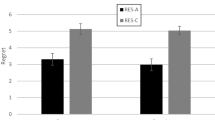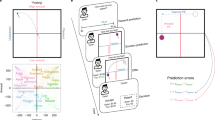Abstract
Consumers base many decisions on affective forecasts, i.e., predictions about future emotions. These predictions, however, are susceptible to systematic biases. The present paper examines the accuracy of predicting emotional change in the consumer context. The goals of the study were to examine whether predictions of a change in consumption-related emotions fit actual experienced change and whether original predictions are remembered correctly. A two-wave longitudinal survey with 86 consumers in Austria and the UK showed that consumers who had bought shoes overestimated the decrease of positive consumption-related emotions over time. Results indicate that the intuitive theory of adaptation is related to the prediction bias. Moreover, participants misremembered original predictions as more consistent with actual experienced emotions. This hindsight bias hinders consumers from learning from previous prediction errors.

Similar content being viewed by others
Notes
An ANCOVA was also conducted, including the variables age and general feeling at wave two as covariates, as these variables were found to differ between conditions or countries. The analysis revealed the same results with a significant time effect, F(3, 246) = 9.97, p < .01, a non-significant group effect, F(1, 80) = 2.37, p = .13, a non-significant country effect, F(1, 80) = 0.93, p = .34, and non-significant interactions (group × country: F(1, 80) = 0.03, p = .86; group × time: F(3, 246) = 0.17, p = .91; country × time: F(3, 246) = 0.52, p = .67; group × country × time: F(3, 246) = 0.49, p = .69). Neither age (β = −0.11, p = .38) nor general feeling at wave two (β = 0.09, p = .41) had a significant effect.
This difference between predictions and current emotions at wave two also remained significant accounting for current emotions at wave one as covariate, F(1, 85) = 5.58, p = .02.
References
Christensen-Szalanski, J., & Willham, C. F. (1991). The hindsight bias: A meta-analysis. Organizational Behavior and Human Decision Processes, 48(1), 147–168.
Cohen, J. (1992). A power primer. Psychological Bulletin, 112(1), 155–159.
Derbaix, C., & Pham, M. T. (1991). Affective reactions to consumption situations: A pilot investigation. Journal of Economic Psychology, 12(2), 325–355.
Dunlap, W. P., Cortina, J. M., Vaslow, J. B., & Burke, M. J. (1996). Meta-analysis of experiments with matched groups or repeated measures designs. Psychological Methods, 1(2), 170–177.
European Commission. (2008). Footwear industry statistics. Retrieved December 22, 2008, from http://ec.europa.eu/enterprise/footwear/statistics.htm
Fischhoff, B. (1975). Hindsight is not equal to foresight: The effect of outcome knowledge on judgment under uncertainty. Journal of Experimental Psychology: Human Perception and Performance, 1(3), 288–299.
Gilbert, D. T., Pinel, E. C., Wilson, T. D., Blumberg, S. J., & Wheatley, T. P. (1998). Immune neglect: A source of durability bias in affective forecasting. Journal of Personality and Social Psychology, 75(3), 617–638.
Gilbert, D. T., Gill, M. J., & Wilson, T. D. (2002). The future is now: Temporal correction in affective forecasting. Organizational Behavior and Human Decision Processes, 88(1), 430–444.
Havlena, W. J., & Holbrook, M. B. (1986). The varieties of consumption experience: Comparing two typologies of emotion in consumer behavior. Journal of Consumer Research, 13(3), 394–404.
Hawkins, S. A., & Hastie, R. (1990). Hindsight: Biased judgments of past events after the outcomes are known. Psychological Bulletin, 107(3), 311–327.
Hirschman, E. C., & Morris, B. H. (1982). Hedonic consumption: Emerging concepts, methods, and propositions. Journal of Marketing, 46, 92–101. Summer.
Hoelzl, E., Kirchler, E., & Rodler, C. (2002). Hindsight bias in economic expectations: I knew all along what I want to hear. Journal of Applied Psychology, 87(3), 437–443.
Hoelzl, E., Pollai, M., & Kamleitner, B. (2009). Experience, prediction and recollection of loan burden. Journal of Economic Psychology, 30(3), 446–454. doi:10.1016/j.joep.2008.11.001.
Holbrook, M. B., & Hirschman, E. C. (1982). The experiential aspects of consumption: Consumer fantasies, feelings, and fun. Journal of Consumer Research, 9(2), 132–140.
Igou, E. R. (2004). Lay theories in affective forecasting: The progression of affect. Journal of Experimental Social Psychology, 40(4), 528–534.
Kahneman, D., & Snell, J. (1992). Predicting a changing taste: Do people know what they will like? Journal of Behavioral Decision Making, 5(3), 187–200.
Ladhari, R. (2007). The effect of consumption emotions on satisfaction and word-of-mouth communication. Psychology & Marketing, 24(12), 1085–1108.
Loewenstein, G., & Adler, D. (1995). A bias in the prediction of tastes. Economic Journal, 105(431), 929–937.
Loewenstein, G., & Schkade, D. (1999). Wouldn’t it be nice? Predicting future feelings. In D. Kahneman, E. Diener & N. Schwartz (Eds.), Well-being: The foundations of hedonic psychology (pp. 85–105). New York: Russell Sage Foundation.
Loewenstein, G., Weber, E. U., Hsee, C. K., & Welch, N. (2001). Risk as feelings. Psychological Bulletin, 127(2), 267–286.
MacInnis, D. J., Patrick, V. M., & Park, C. W. (2005). Looking through the crystal ball: The role of affective forecasting and misforecasting in consumer behaviour. Review of Marketing Research, 2, 43–79.
Mano, H., & Oliver, R. L. (1993). Assessing the dimensionality and structure of the consumption experience: Evaluation, feeling, and satisfaction. Journal of Consumer Research, 20(3), 451–466.
Mellers, B., & McGraw, A. P. (2001). Anticipated emotions as guides to choice. Current Directions in Psychological Science, 10(6), 210–214.
Mellers, B., Schwartz, A., & Ritov, I. (1999). Emotion-based choice. Journal of Experimental Psychology: General, 128(3), 332–345.
Meyvis, T., Ratner, R. K., & Levav, J. (2007). Why we don’t learn to accurately forecast our feelings: How misremembering our predictions blinds us to our past forecasting errors. Columbia University: Working paper. 2007.
Patrick, V. M., MacInnis, D. J., & Park, C. W. (2007). Not as happy as I thought I’d be? Affective misforecasting and product evaluations. Journal of Consumer Research, 33(4), 479–489.
Pham, M. T. (1998). Representativeness, relevance, and the use of feelings in decision making. Journal of Consumer Research, 25, 144–159.
Phillips, D. M., & Baumgartner, H. (2002). The role of consumption emotions in the satisfaction response. Journal of Consumer Psychology, 12(3), 243–252.
Ratner, R. K., Soman, D., Zauberman, G., Ariely, D., Carmon, Z., Keller, P. A., et al. (2008). How behavioral decision research can enhance consumer welfare: From freedom of choice to paternalistic intervention. Marketing Letters, 19(3–4), 383–397.
Read, D., & van Leeuwen, B. (1998). Predicting hunger: The effects of appetite and delay on choice. Organizational Behavior and Human Decision Processes, 76(2), 189–205.
Richins, M. L. (1997). Measuring emotions in the consumption experience. Journal of Consumer Research, 24, 127–146.
Ross, M. (1989). Relation of implicit theories to the construction of personal histories. Psychological Review, 96(2), 341–357.
Shiv, B., & Huber, J. (2000). The impact of anticipating satisfaction on consumer choice. Journal of Consumer Research, 27(2), 202–216.
Simonson, I. (1990). The effect of purchase quantity and timing on variety-seeking behavior. Journal of Marketing Research, 27(2), 150–162.
Simonson, I. (1992). The influence of anticipating regret and responsibility on purchase decisions. Journal of Consumer Research, 19(1), 105–118.
Snell, J., Gibbs, B. J., & Varey, C. (1995). Intuitive hedonics: Consumer beliefs about the dynamics of liking. Journal of Consumer Psychology, 4(1), 33–60.
Soscia, I. (2007). Gratitude, delight, or guilt: The role of consumers’ emotions in predicting postconsumption behaviors. Psychology & Marketing, 24(10), 871–894.
Ubel, P. A., Loewenstein, G., & Jepson, C. (2005). Disability and sunshine: Can hedonic predictions be improved by drawing attention to focusing illusions or emotional adaption? Journal of Experimental Psychology, 11(2), 111–123.
Voss, K. E., Spangenberg, E. R., & Grohmann, B. (2003). Measuring the hedonic and utilitarian dimensions of consumer attitude. Journal of Marketing Research, 40(3), 310–320.
Wang, J., Novemsky, N., & Dhar, R. (2009). Anticipating adaptation to products. Journal of Consumer Research, 36(2), 149–159. doi:10.1086/597050.
Watson, D., Clark, L. A., & Tellegen, A. (1988). Development and validation of brief measures of positive and negative affect: The PANAS scale. Journal of Personality and Social Psychology, 54(6), 1063–1070.
Westbrook, R. A., & Oliver, R. L. (1991). The dimensionality of consumption emotion patterns and consumer satisfaction. Journal of Consumer Research, 18(1), 84–91.
Wilson, T. D., & Gilbert, D. T. (2003). Affective forecasting. In M. Zanna (Ed.), Advances in experimental social psychology (Vol. 35, pp. 345–411). New York: Elsevier.
Wilson, T. D., Wheatley, T. P., Meyers, J. M., Gilbert, D. T., & Axsom, D. (2000). Focalism: A source of durability bias in affective forecasting. Journal of Personality and Social Psychology, 78(5), 821–836.
Wood, G. (1978). The knew-it-all-along effect. Journal of Experimental Psychology: Human Perception and Performance, 4(2), 345–353.
Zwick, R., Pieters, R., & Baumgartner, H. (1995). On the practical significance of hindsight bias: The case of the expectancy-disconfirmation model of consumer satisfaction. Organizational Behavior and Human Decision Processes, 64(1), 103–117.
Acknowledgments
We thank Nina Stonitsch for her help in data collection.
Author information
Authors and Affiliations
Corresponding author
Rights and permissions
About this article
Cite this article
Pollai, M., Hoelzl, E. & Possas, F. Consumption-related emotions over time: Fit between prediction and experience. Mark Lett 21, 397–411 (2010). https://doi.org/10.1007/s11002-009-9090-5
Published:
Issue Date:
DOI: https://doi.org/10.1007/s11002-009-9090-5




